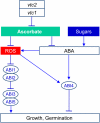Ascorbate and glutathione: the heart of the redox hub
- PMID: 21205630
- PMCID: PMC3075780
- DOI: 10.1104/pp.110.167569
Ascorbate and glutathione: the heart of the redox hub
Figures






References
-
- Acosta IF, Farmer EE. (2010) Jasmonates. The Arabidopsis Book. American Society of Plant Biologists, Rockville, MD, doi/10.1199:tab.0129, http://www.aspb.org/publications/arabidopsis/ - PMC - PubMed
-
- Allen JF, Hall DO. (1973) Superoxide reduction as a mechanism of ascorbate-stimulated oxygen uptake by isolated chloroplasts. Biochem Biophys Res Commun 52: 856–862 - PubMed
-
- Arrigoni O, De Tullio MC. (2002) Ascorbic acid: much more than just an antioxidant. Biochim Biophys Acta 1569: 1–9 - PubMed
-
- Asada K. (1999) The water-water cycle in chloroplasts: scavenging of active oxygens and dissipation of excess photons. Annu Rev Plant Physiol Plant Mol Biol 50: 601–639 - PubMed
Publication types
MeSH terms
Substances
LinkOut - more resources
Full Text Sources
Other Literature Sources
Medical

